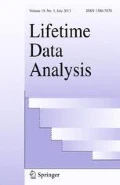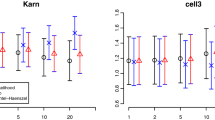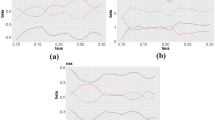Abstract
The Kaplan–Meier estimator is ubiquitously used to estimate survival probabilities for time-to-event data. It is nonparametric, and thus does not require specification of a survival distribution, but it does assume that the risk set at any time t consists of independent observations. This assumption does not hold for data from paired organ systems such as occur in ophthalmology (eyes) or otolaryngology (ears), or for other types of clustered data. In this article, we estimate marginal survival probabilities in the setting of clustered data, and provide confidence limits for these estimates with intra-cluster correlation accounted for by an interval-censored version of the Clayton–Oakes model. We develop a goodness-of-fit test for general bivariate interval-censored data and apply it to the proposed interval-censored version of the Clayton–Oakes model. We also propose a likelihood ratio test for the comparison of survival distributions between two groups in the setting of clustered data under the assumption of a constant between-group hazard ratio. This methodology can be used both for balanced and unbalanced cluster sizes, and also when the cluster size is informative. We compare our test to the ordinary log rank test and the Lin-Wei (LW) test based on the marginal Cox proportional Hazards model with robust standard errors obtained from the sandwich estimator. Simulation results indicate that the ordinary log rank test over-inflates type I error, while the proposed unconditional likelihood ratio test has appropriate type I error and higher power than the LW test. The method is demonstrated in real examples from the Sorbinil Retinopathy Trial, and the Age-Related Macular Degeneration Study. Raw data from these two trials are provided.


Similar content being viewed by others
References
Age-Related Eye Disease Study Research Group (2001) A randomized, placebo-controlled, clinical trial of high-dose supplementation with vitamins C and E, beta carotene, and zinc for age-related macular degeneration and vision loss: AREDS report no. 8. Arch Ophthalmol 119(10):1417–1436
Betensky RA, Finkelstein DM (1999) A non-parametric maximum likelihood estimator for bivariate interval censored data. Stat Med 18(22):3089–3100 (PMID: 10544308)
Broyden CG (1970) The convergence of a class of double-rank minimization algorithms. J Inst Math Appl 6:76–90
Clayton DG (1978) A model for association in bivariate life-tables and its application in epidemiological studies of familial tendency in chronic disease incidence. Biometrika 65:141–151
Fletcher R (1987) Practical methods of optimization. John Wiley & Sons, New York
Gehan EA (1965) A generalized Wilcoxon test for comparing arbitrarily single censored samples. Biometrika 52:203–223
Harrington DP, Fleming TR (1982) A class of rank test procedures for censored survival data. Biometrika 69:133–143
Hougaard P (1995) Frailty models for survival data. Lifetime Data Anal 1:255–273
Huster WJ, Brookmeyer R, Self SG (1989) Modelling paired survival data with covariates. Biometrics 45(1):145–156
Jung S (1999) Rank tests for matched survival data. Lifetime Data Anal 5:67–79
Jung S, Jeong J (2003) Rank tests for clustered survival data. Lifetime Data Anal 9:21–33
Klein JP (1992) Semiparametric estimation of random effects using the Cox model based on the EM algorithm. Biometrics 48:795–806
Lee EW, Wei LJ, Amato DA (1992) Cox–type regression analysis for large numbers of small groups of correlated failure time observations. In: Klein JP, Goel PK (eds) Survival analysis: state of the art. Kluwer Academic Publishers, Amsterdam, pp 237–247
Lee EW, Wei LJ, Ying Z (1993) Linear regression analysis for highly stratified failure time data. J Am Stat Assoc 88:557–565
Lee CF, Cheng AC, Fong DY (2012) Eyes or subjects: are ophthalmic randomized controlled trials properly designed and analyzed? Ophthalmology 119(4):869–872
Lin DY (1994) Cox regression analysis of multivariate failure time data: the marginal approach. Stat Med 13:2233–2247
Lin DY, Wei LJ (1989) Regression analysis of multivariate incomplete failure time data by modeling marginal distributions. J Am Stat Assoc 84:1074–1078
Mantel N (1966) Evaluation of survival data and two new rank order statistics arising in its consideration. Cancer Chemo Rep 50:163–170
Oakes D (1982) A model for association in bivariate survival data. JRSS B 44(3):414–422
Peto R, Peto J (1972) Asymptotically efficient rank invariant test procedures (with discussion). J R Stat Soc Series A 135:185–206
Prentice RL (1978) Linear rank tests with right censored data. Biometrika 65:167–179
Prentice R (2016) Higher dimensional Clayton–Oakes models for multivariate failure time data. Biometrika 103(1):231–236
Prentice R, Zhao S (2018) Nonparametric estimation of the multivariate survivor function: the multivariate Kaplan–Meier estimator. Lifetime Data Anal 24(1):3–27
Rosner B (1982) Statistical methods in ophthalmology: an adjustment for the intraclass correlation between eyes. Biometrics 38:105–114
Savage IR (1956) Contributions to the theory of rank order statistics—the two sample case. Ann Math Stat 27:590–615
Shih JH, Louis TA (1995) Assessing gamma frailty models for clustered failure time data. Lifetime Data Anal 1:205–220
Sorbinil Retinopathy Trial Research Group (1990) A randomized trial of Sorbinil, an aldose reductase inhibitor, in diabetic retinopathy. Arch Ophthalmol 108:1234–1244
Sun J (2006) The statistical analysis of interval-censored failure time data. Springer
Sun L, Wang L, Sun J (2006) Estimation of the association for bivariate interval-censored failure time data. Scand J Stat 33:637–649
Tarone RE, Ware J (1977) On distribution-free tests for equality of survival distributions. Biometrika 64:156–160
Wang W, Ding AA (2000) On assessing the association for bivariate current status data. Biometrika 87:879–893
Wellner JA, Zhan Y (1997) A hybrid algorithm for computation of the nonparametric maximum likelihood estimator from censored data. J Am Stat Assoc 92:945–959
Ying Z, Wei LJ (1994) The Kaplan–Meier estimate for dependent failure time observations. J Multivar Anal 50:17–29
Zeng D, Gao F, Lin DY (2017) Maximum likelihood estimation for semiparametric regression models with multivariate interval-censored data. Biometrika 104(3):505–525 (PMID: 29391606; PMCID: PMC5787874)
Zhang HG, Ying GS (2018) Statistical approaches in published ophthalmic clinical science papers: a comparison to statistical practice two decades ago. Br J Ophthalmol 102(9):1188–1191
Funding
The funding was provided by Foundation for the National Institutes of Health (Grant No. EY022445).
Author information
Authors and Affiliations
Corresponding author
Additional information
Publisher's Note
Springer Nature remains neutral with regard to jurisdictional claims in published maps and institutional affiliations.
Supplementary Information
Below is the link to the electronic supplementary material.
Rights and permissions
Springer Nature or its licensor (e.g. a society or other partner) holds exclusive rights to this article under a publishing agreement with the author(s) or other rightsholder(s); author self-archiving of the accepted manuscript version of this article is solely governed by the terms of such publishing agreement and applicable law.
About this article
Cite this article
Rosner, B., Bay, C., Glynn, R.J. et al. Estimation and testing for clustered interval-censored bivariate survival data with application using the semi-parametric version of the Clayton–Oakes model. Lifetime Data Anal 29, 854–887 (2023). https://doi.org/10.1007/s10985-022-09588-y
Received:
Accepted:
Published:
Issue Date:
DOI: https://doi.org/10.1007/s10985-022-09588-y




